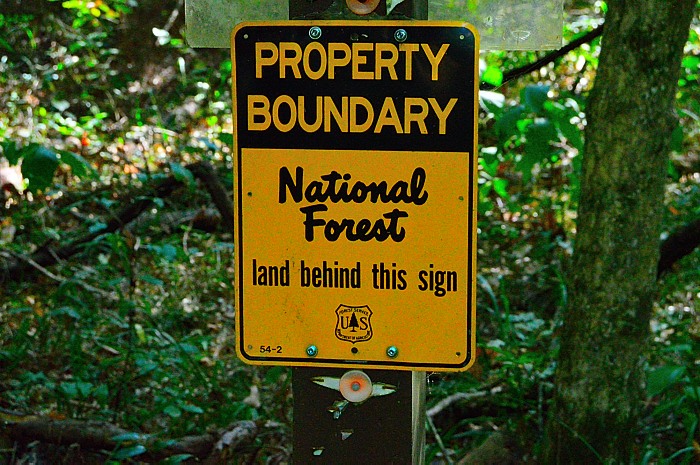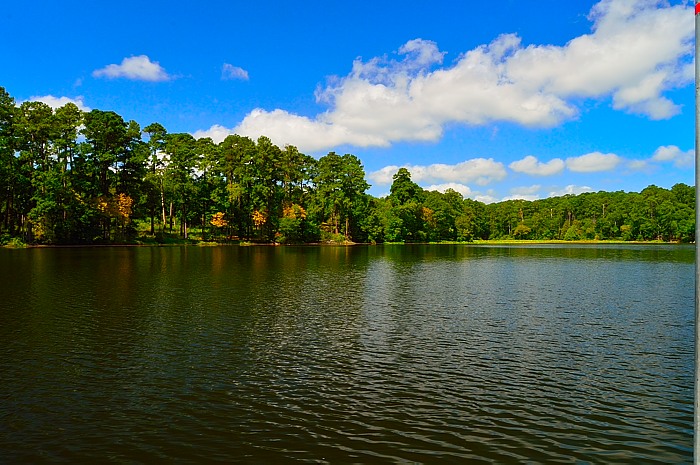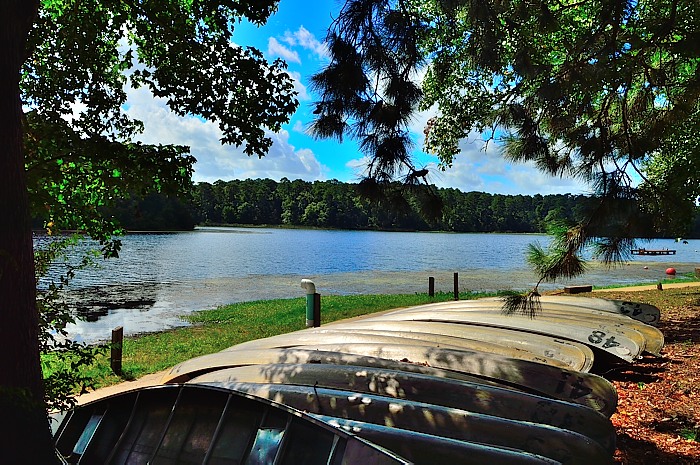A young American grew up among the Cherokee in Tennessee and later married a Cherokee woman. Imposing by character and courage, he was respected by all who knew him—the Cherokee gave him the name “Coleneh,” which means “raven”. An ambitious Sam Houston would later move to Texas and father a new republic. In his storied lifetime he served as commander-in-chief of Texas forces during the war for independence, first president of the Republic of Texas, and governor of the State of Texas. In the mid-1840’s he bought a plantation near present-day Huntsville, Texas, naming it Raven Hill in recognition of his Cherokee name. Today, a colossal statue of general Sam Houston towers over Huntsville, near the entrance to Huntsville State Park.
Houston’s legacy is imprinted all over the park. At sunrise, the eastern sky pales to shades of pink and dove grey over Raven Lake. With the morning bright and the brush wet, hikers marvel at the scenery on Coleneh Trail. At its edge, the park abuts the sprawling Sam Houston National Forest—its trail system interlinked, the boundary marked only by an unassuming sign.
For people living in Texas’s largest city, getting out into nature can sometimes be a tall order. Located just north of the city, Houstonians make Huntsville State Park a prime destination. This park is clearly designed for maximizing fun in the sun and water. Off Interstate 45 just six miles outside the town of Huntsville on Park Road 40, it was tricky to access from the highway when I visited. That’s because extensive construction blocked the marked exit, and scant signage strung me along another mile before an improvised road looped back to the entrance. When the road is not under construction, it’s an easy exit. Just saying.
Huntsville State Park is magnificent wilderness. The deeply wooded park is split into two peninsulas by Lake Raven, offering all facilities easy access to water. Rife with camping areas on both capes, screen shelters run right up to the water, and the center beach of the lake offers a large unsupervised swimming area, a well-stocked camp store (ice cream, shaved ice, snacks, souvenirs, fishing supplies) and a marina which rents kayaks, canoes, and paddleboats. All around the swimming area is a huge parking lot, suggesting big crowds during the heat of summer weekends. Long, shaded stretches of grass along the road are dotted with picnic tables under mighty green cathedral-vaulted trees arching overhead. Everyone enjoys a water view.
Raven Lake is only 210 acres, so boating is restricted to wakeless speeds and fishing reigns supreme. In addition to the boat ramp and parking, there are multiple fishing piers and fish cleaning stations. Whether you drop a line over the bank or head out in a boat, anglers go after bass, crappie, perch and catfish. Incidentally, while fishing from the shoreline is allowed, be careful. With two streams feeding the lake (Big and Little Chinquapin Creeks) and only one draining it (Prairie Branch), lakesides tend to be swampy—and there are alligators in the park. All these streams join East Sandy Creek and later feed the West Fork of the San Jacinto River about seven miles downstream.
This is also a singular retreat for nature lovers. Tall loblolly pines mixed among southern red oaks and sweetgums tower overhead in the upland portions of the park. Streams and creeks are thick with water oaks, white oaks and blackgum. It’s not unusual to find bright red splashes of Turk’s cap under the canopy or lacey white dogwoods flashing from the understory. Rich, verdant colors are everywhere in the forest, thriving in the humidity. At an opening to the lake, just off Coleneh Trail, is a busy bird blind usually overrun with waterfowl and songbirds. Of the 654 species of birds documented in Texas, over half are migratory. Spring migration (late April, early May) is a busy time in the park; a modern nature center along the main entrance chronicles these birds, as well as other flora and fauna.
The trail system is extensive, connecting and intertwining 21 miles of hike and bike paths. At the far end of Prairie Branch Loop, a wooden walkway leads you—like a yellow brick road—out of the park into the deep, imposing Sam Houston National Forest. All takers are welcome in these backwoods. Horseback riders and all-terrain vehicles (with a proper U.S. Forest Service permit) are received year-round on specially designated trails. Foot soldiers entering the national forest can hike their way around the well-marked Lone Star Hiking Trail. At over 128 miles long, this celebrated pathway is the only officially long-distance National Recreation Trial in all of Texas. This is old growth forest at its best—just make sure someone knows your plans.
Within the state park, catching a glance of wildlife takes patience; if I were a white-tailed deer, opossum, or raccoon, I couldn’t hope for a more protected woodland paradise. Dusk and dawn are favorite times of day for dropping by for a cool drink—something resident alligators know all too well—or foraging the forest for a tasty meal. Twilight is an especially good time to be out and about, given the sauna-like conditions. The squirrels that play in the treetops here are eastern grays—they don’t spend much time on the ground like fox squirrels do. Aside from the occasional gator, there is little in the way of exotic wildlife—common Texas species rule.
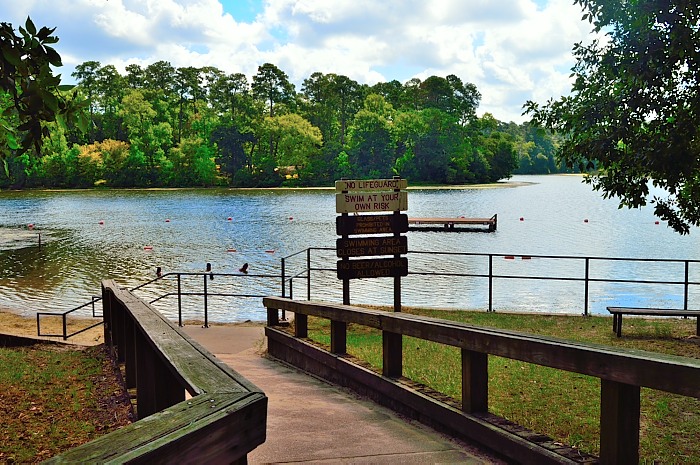
Despite how it might sound, the park was not created by the Big Bang. It evolved. The park’s story is one of vision and perseverance. The area around Huntsville had been used as a recreation site for a long time. Back in the 1930’s, two CCC companies did firefighting and flood control in the area while also building unpaved roads (some of which were later used for the park). The Huntsville-Walker County Chamber of Commerce eventually approached the Texas State Parks Board to lobby for locating a state park near the city. By 1936, after the sale of bonds, the community was able to finally pay for the land. In 1937 work began, spearheaded by an experienced company of African American World War I veterans (Company 1823 [CV]). They built the buildings, the dam and spillway, and cleared the future lake bed of standing timber before filling Lake Raven.
Through 1942, other projects were completed, to include helping reforest the park. With the advent of World War II, the CCC’s work came to an end before they finished. Next up, the Works Progress Administration (WPA) workers and prison laborers toiled in the park, allowing it to open for limited activities during the war years. Postwar projects continued, of course, and the Chamber of Commerce finally dedicated and opened Huntsville State Park to the public on Friday, May 18, 1956. Today, after 20 years a work in progress, the park stands as a monument to the persistence and tenacity of the Huntsville community.
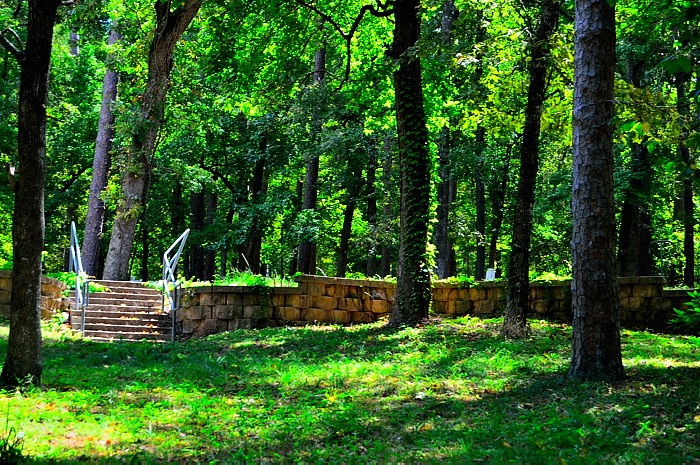
It’s true all state parks in Texas share a similar look, common signage, and comparable amenities. Some might say, when you’ve seen one you’ve seen them all—but they would be wrong. With ten separate ecoregions in the state, it’s the dissimilarities which provide the payoff. Differences are what makes visiting our state parks colorful, rewarding and worth the effort. Different terrain, different weather, different wildlife—just like pavilions in a great big theme park—give insight into how other Texans enjoy their outdoors. At Huntsville, we find the Jurassic Park pavilion. All seems new-born, steamy and primordial. As you navigate the wilderness with its warm, fecund scent, you sense the hidden gaze of glistening black animal eyes. You feel alert, a locking sensation—things in balance.
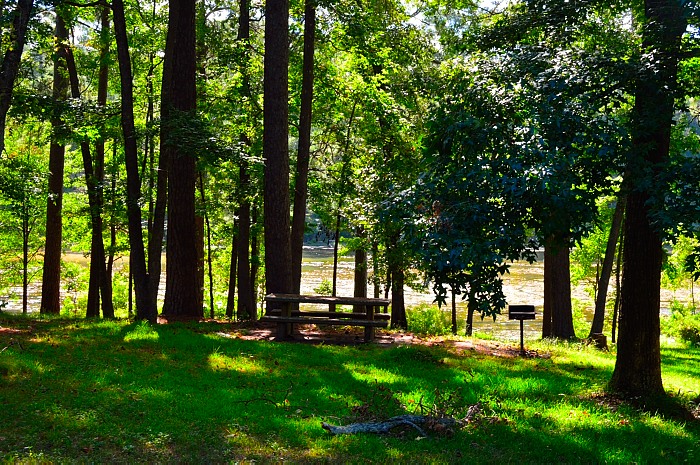
In this carefully-developed park, everyone has choices. Some like the fishing, some seek a refreshing swim to escape summer’s teeth, and yet others find solace in the silent skim of a gliding kayak. We all need a place to rediscover, refresh and forget about our daily grind. Is it any wonder, then, that tense urbanites are drawn to the forestland which also first attracted Sam Houston? Go ahead, make a plan—and take a road trip!


